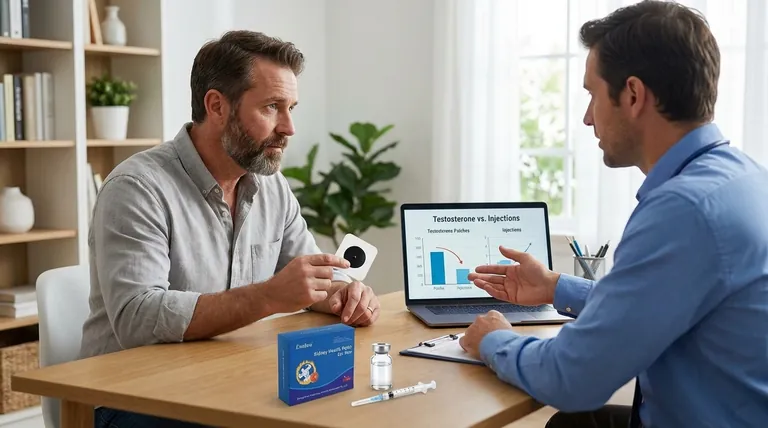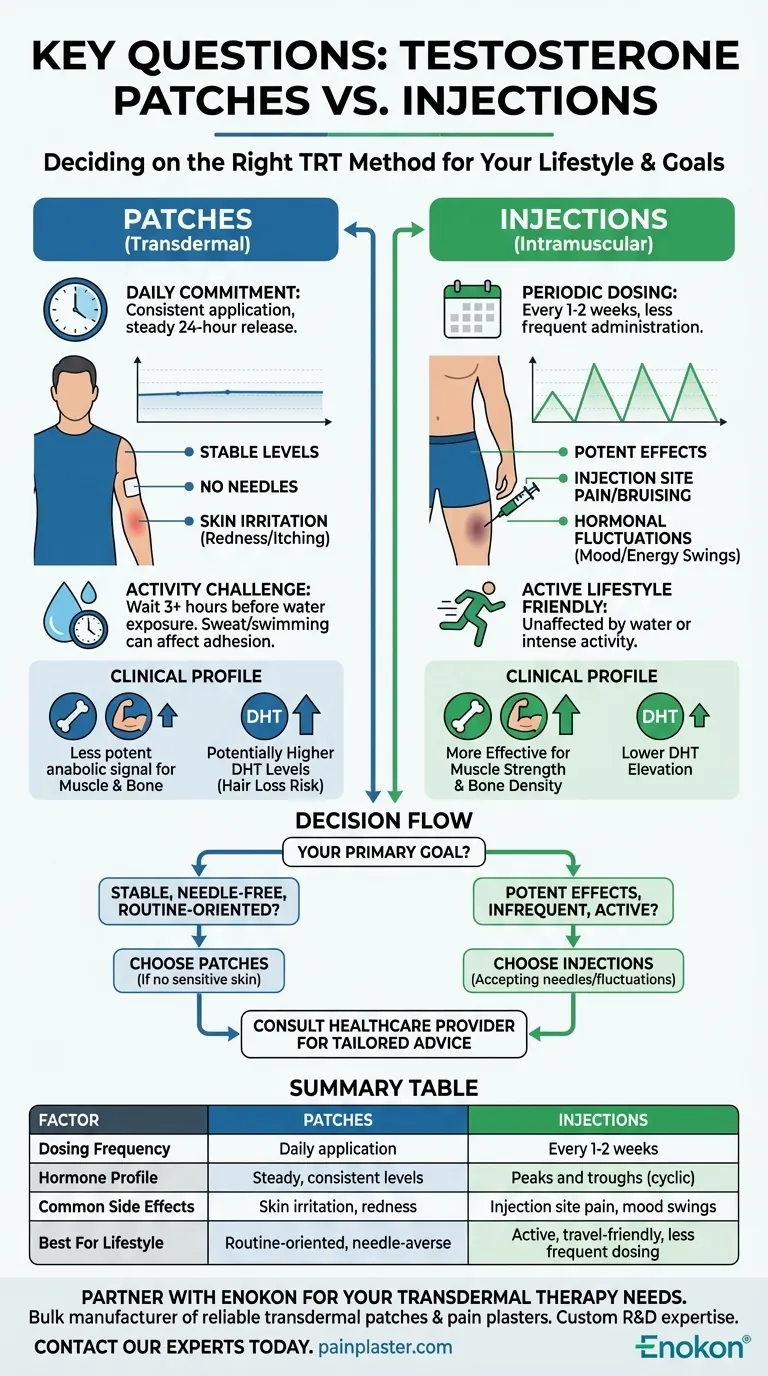When choosing between testosterone patches and injections, the key questions revolve around your lifestyle, your comfort with different administration methods, and your specific health goals. You should consider the severity of your testosterone deficiency, whether you prefer a steady daily hormone release (patches) or a more potent, periodic dose (injections), and your tolerance for potential side effects like skin irritation or injection pain.
The core decision between testosterone patches and injections is a trade-off between the daily convenience and stable hormone levels of a patch versus the less frequent, more potent application of an injection. Your personal lifestyle, activity level, and medical needs—as determined with your healthcare provider—will be the deciding factors.

Efficacy and Hormonal Profile
The way testosterone is delivered into your body significantly impacts its effects and how you feel. Patches and injections create very different hormonal patterns.
Steady vs. Pulsed Delivery
Testosterone patches are designed to mimic the body's natural, consistent release of hormones. They deliver a steady, controlled dose over a 24-hour period, which can lead to more stable energy and mood levels.
In contrast, injections create a "peak and trough" cycle. You receive a large dose that peaks shortly after the injection and then gradually declines until the next one. This can sometimes lead to fluctuations in mood or energy.
Impact on Muscle and Bone
Research suggests that the delivery method can influence clinical outcomes. In some studies, injections have been shown to be more effective at preventing bone density loss and increasing muscle strength compared to patches.
This may be due to the higher peak testosterone levels achieved with injections, which can provide a more powerful anabolic signal to muscle and bone tissue.
Influence on Other Hormones
The administration route can also affect how testosterone is metabolized. Some evidence suggests that patches and other forms (like oral TRT) may elevate levels of Dihydrotestosterone (DHT) more than injections do.
DHT is a potent androgen linked to effects like hair loss and prostate growth, making this an important factor to discuss with your doctor.
Lifestyle and Practical Considerations
Your daily routine and personal preferences are just as important as the clinical data when choosing a TRT method.
Daily Routine vs. Periodic Dosing
Patches require a daily commitment. You must remember to apply a new patch every day, typically in the evening, as part of your routine.
Injections are far less frequent, usually administered once every one to two weeks. This can be more convenient for those who travel often or don't want a daily medical task.
Activity and Water Exposure
Patches can be a challenge for highly active individuals. Excessive sweating, swimming, or frequent showering can cause the patch to loosen or fall off, compromising your dose.
You must typically wait at least three hours after applying a patch before showering or swimming. If a patch does fall off, the replacement protocol depends on the time of day.
Comfort with Needles vs. Skin Application
This is a straightforward personal preference. Many people have a strong aversion to needles and find the idea of self-injecting intimidating or unpleasant.
For these individuals, a daily patch is a much more comfortable and less stressful option, despite the potential for skin irritation.
Understanding the Trade-offs and Side Effects
Neither method is perfect, and both come with potential downsides that you must weigh.
Skin Irritation with Patches
The most common complaint with testosterone patches is skin irritation, redness, or itching at the application site.
To manage this, you must rotate application sites daily and wait at least seven days before reusing the same spot. Patches should never be applied to the scrotum, broken skin, or areas under pressure from clothing.
Injection Site Pain and Fluctuation
While injections avoid skin irritation, they can cause pain, swelling, or bruising at the injection site.
The hormonal peaks and troughs mentioned earlier can also be a significant side effect for some men, leading to noticeable shifts in energy, libido, and mood throughout the injection cycle.
Potential Prostate Health Considerations
Some data has suggested that patches might be associated with a higher risk of increasing prostate cancer risk markers compared to injections.
This is a complex topic and should be a key point of discussion with your healthcare provider, who can monitor your prostate health (via PSA tests) regardless of the TRT method you choose.
Making the Right Choice for Your Goal
Ultimately, the best method is the one that aligns with your health needs, lifestyle, and personal comfort.
- If your primary focus is stable, daily hormone levels and avoiding needles: The testosterone patch is likely the superior choice, provided you don't have sensitive skin.
- If your primary focus is potent effects, infrequent dosing, and cost-effectiveness: Injections are generally more effective for building muscle and bone and require less frequent administration.
- If you have sensitive skin or a highly active, water-intensive lifestyle: Injections are a more practical option, as patches may be difficult to keep adhered and can cause significant skin irritation.
Consulting with your healthcare professional is the essential final step to tailor this decision to your unique medical profile.
Summary Table:
| Factor | Testosterone Patches | Testosterone Injections |
|---|---|---|
| Dosing Frequency | Daily application | Every 1-2 weeks |
| Hormone Profile | Steady, consistent levels | Peaks and troughs (cyclic) |
| Common Side Effects | Skin irritation, redness | Injection site pain, mood swings |
| Best For Lifestyle | Routine-oriented, needle-averse | Active, travel-friendly, less frequent dosing |
Partner with Enokon for Your Transdermal Therapy Needs
As a bulk manufacturer of reliable transdermal patches and pain plasters, Enokon provides healthcare and pharmaceutical distributors and brands with the technical expertise for custom R&D and development. Whether your product line requires the steady delivery of a patch or another transdermal solution, our team can help you bring effective, high-quality products to market.
Contact our experts today to discuss how we can support your specific requirements.
Visual Guide

Related Products
- Prostate Pain Kidney Health Care Patch for Men
- Capsaicin Chili Medicated Pain Relief Patches
- Far Infrared Deep Heat Relief Patches Medicated Pain Relief Patches
- Heating Pain Relief Patches for Menstrual Cramps
- Herbal Eye Protection Patch Eye Patch
People Also Ask
- How often should testosterone patches be applied? Daily Dosage & Best Practices
- What should be done before undergoing an MRI while using testosterone patches? Remove it to prevent serious burns.
- What should be done if a testosterone patch falls off? A Guide to Maintaining Hormone Stability
- What should be done in case of a testosterone patch overdose? A Step-by-Step Emergency Guide
- What precautions should be taken when applying testosterone patches? Maximize Safety and Effectiveness












